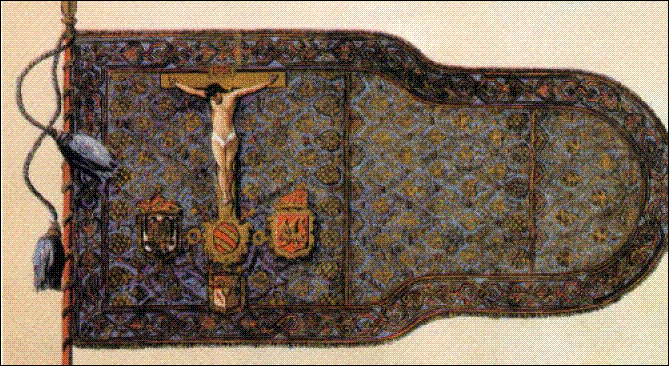The Blessed Virgin, as Queen of heaven and of souls, has a right to the same homage; wherefore the Church asks us to recognize the title of Mary as Queen of the Holy Rosary, and she exhorts us to offer to her as daughter of the Father, mother of the Son and spouse of the Holy Ghost a triple chaplet or three crowns of roses, of which she shows us all the beauties in to-day's office, and to which she has given the name of Rosary.
The Collect reminds us that the recitation of the Rosary is a mental prayer in which we meditate on the mysteries of the life, death and resurrection of Jesus; with these Mary was intimately associated.
The Gospel, which gives us the chief part of the angelical salutation, shows us that the Rosary is a vocal prayer. The Pater, Credo and the Gloria, which are recited with the Ave Marias, are also found in the Mass or in the Divine Office.
The Rosary, as a private devotion, consists therefore of elements taken from the liturgical Cycle, and the feast of the Rosary forms part of the Cycle.
The feast of the Most Holy Rosary is a summary of the liturgical year, as we meditate on the mysteries, and also of the breviary, as we recite hundred-fifty Ave Marias corresponding to hundred-fifty psalms ending by Gloria Patri: it shows in an admirable triptych the joyful, sorrowful and glorious events in the lives of Jesus and Mary which are recalled in succession in the Catholic calendar. In the Christmas Cycle the soul, plunged in an atmosphere of Joy, meditates on the five joyful mysteries, on Wednesdays and Fridays of Ember Week in Winter, on Christmas Day, on February 2 and on the Sunday in the Octave of the Epiphany. Again she contemplates, during the season of the Passion, the five sorrowful mysteries on Holy Thursday and Good Friday. Lastly, she sympathizes amid the joys of the Paschal Season and Pentecost with the five glorious mysteries at the feasts of Easter, Ascension, Pentecost and the Assumption of the Virgin. There is a plenary indulgence similar to that of the Portiuncula to be gained on the day of this feast by all the faithful who visit a church where the Archconfraternity of the Rosary is established.
 This prayer has, in the course of the centuries, obtained many graces for Christendom. The feast of our Lady of the Rosary was instituted to commemorate the victory of Lepanto (Sunday, October 7, 1571) when, thanks to the recitation of the Rosary, the forces of Islam, which threatened to invade Europe, were broken. Gregory prescribed this feast, replacing very significantly the feast of our Lady of Victory, for certain churches. It was extended to the Catholic world by Clement XI, in thanksgiving for another triumph over the same foes in Hungary in 1716 under Charles VI.
This prayer has, in the course of the centuries, obtained many graces for Christendom. The feast of our Lady of the Rosary was instituted to commemorate the victory of Lepanto (Sunday, October 7, 1571) when, thanks to the recitation of the Rosary, the forces of Islam, which threatened to invade Europe, were broken. Gregory prescribed this feast, replacing very significantly the feast of our Lady of Victory, for certain churches. It was extended to the Catholic world by Clement XI, in thanksgiving for another triumph over the same foes in Hungary in 1716 under Charles VI.Leo XIII, moved by the sorrowful trials under which the Church groans, raised the feast to one of the second Class with a new Mass and office.
Gaudeamus omnes in Domino, diem festum celebrantes sub honore Beatae Mariae Virginis: de cujus solemnitate gaudent Angeli, et collaudant Filium Dei. * Eructavit cor meum verbum bonum: dico ego opera mea Regi.
Let us all rejoice in the Lord, celebrating a festival-day in honour of the blessed Virgin Mary, for whose solemn festival the angels rejoice and give praise to the Son of God. * My heart hath uttered a good word: I speak my works to the king.
(Psalm 44:2 from the Introit of Mass)
Deus, cujus Unigenitus per vitam, mortem et resurrectionem suam nobis salutis aeternae praemia comparavit: concede, quaesumus; ut, haec mysteria sacratissimo beatae Mariae Virginis Rosario recolentes, et imitemur quod continent, et quod promittunt, assequamur.
O God, whose only-begotten Son, by His life, His death and His resurrection hath purchased for us the reward of eternal salvation; grant, we beseech Thee, that meditating on these mysteries in the most holy Rosary of the Blessed Virgin Mary, we may both imitate what they contain and obtain what they promise.
(Collect)
Lesson from the Book of Wisdom.
The Lord possessed me in the beginning of His ways, before He made anything, from the beginning. I was set up from eternity, and of old, before the earth was made. The depths were not as yet, and I was already conceived. Now therefore, ye children, hear me : blessed are they that keep my ways. Hear instruction, and be wise, and refuse it not. Blessed is the man that heareth me, and that watcheth daily at my gates; and waiteth at the posts of my doors. He that shall find me, shall find life, and shall have salvation from the Lord.
(Proverbs 8:22-24,32-35)
From the Catholic Encyclopaedia: http://www.newadvent.org/cathen/13189a.htm


No comments:
Post a Comment